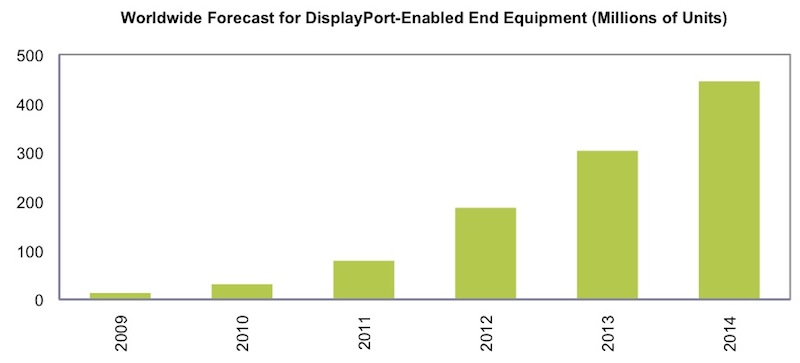![]() IHS iSuppli announced it forecasts that global factory shipments of DisplayPort-enabled PC equipment will amount to 78.9 million units in 2011, up 154.6% from 2010.
IHS iSuppli announced it forecasts that global factory shipments of DisplayPort-enabled PC equipment will amount to 78.9 million units in 2011, up 154.6% from 2010.
For more information visit: www.isuppli.com
Unedited press release follows:
Apple Spurs 154.6 Percent Increase in DisplayPort Interface Shipments in 2011
El Segundo, Calif., April 25, 2011—Fueled by Apple Inc.’s adoption, the DisplayPort digital display interface standard is gaining rapid momentum in 2011, with shipments in PC-related equipment expected to rise by a triple-digit percentage this year, according to new IHS iSuppli research.
Global factory shipments of DisplayPort-enabled PC equipment will amount to 78.9 million units in 2011, up 154.6 percent from 31 million units in 2010, as presented in the attached figure.
The year will represent a peak period of DisplayPort growth. Growth in 2011 will exceed the 2010 expansion of 136.5 percent and also outpace next year’s anticipated 137 percent increase. While growth rates will taper off during the following years, annual shipments of DisplayPort-equipped devices will rise to 445.2 million units by 2014.
“Although DisplayPort had been around for several years, the technology achieved only sporadic usage until 2009, when Apple began to support the interface as a standard feature of its notebook and desktop designs,” said Randy Lawson, manager and principal analyst for display and consumer electronics at IHS. “This provided the essential momentum to drive DisplayPort beyond the nascent stage and into the mainstream. With the strong adoption of DisplayPort from system and chip vendors, and declining support for the existing video graphic adapter (VGA) standard, the new technology will experience rapid growth in the coming years.”
As the long-awaited replacement for the decades-old VGA interface, DisplayPort is being used in the computing equipment market for devices including mobile PCs, desktop PCs, graphics cards, flat-panel monitors and business projectors. DisplayPort derivatives such as internal DisplayPort (iDP) and embedded DisplayPort (eDP) also are designed to provide a simpler, lower-cost serial interface alternative to the older, bulkier solutions based on low-voltage differential signaling (LVDS), a system for transporting video and graphics data from PC and TV motherboards to the integrated LCD panels.
Prior to the adoption by Apple, only occasional sightings of DisplayPort had been made in the market. Early supporters included Dell Inc. and Hewlett-Packard Co., which offered a smattering of DisplayPort equipped notebook and desktop PCs. Furthermore, Lenovo Group added DisplayPort into a few product lines for the ThinkPad docking station.
Since then, DisplayPort has made additional headway. In particular, all three major vendors of PC microprocessors and graphics processing units—Intel Corp., AMD Inc. and nVidia—have moved to integrate DisplayPort into their current product lines, with the companies signaling a five-year horizon to finally end support for VGA.
Mobile PCs lead the DisplayPort charge
The DisplayPort interface will find its widest application this year in mobile PCs. About 41.8 million notebooks will ship with the interface in 2011, compared to 14.7 million last year. The penetration will exceed 72 percent by 2014, with processor designs and slim form factors forcing a rapid transition away from VGA, IHS iSuppli figures show.
The second-largest application of DisplayPort will be in graphics cards, shipping with 14.7 million units this year, up from approximately 7.0 million in 2010. Desktop PCs are third, with DisplayPort-enabled shipments this year of 12.3 million.
Combined shipments of DisplayPort-enabled PCs will jump from 20.1 million units in 2010 to 54.1 million this year, on their way to a projected 341.2 million units by 2014. An inflection point will occur from 2013 onward as DisplayPort deepens penetration in PCs very quickly and as VGA is phased out of motherboard designs, IHS predicts. And by 2016, the adoption rate of DisplayPort for desktop and mobile PCs likely will be more than 90 percent—and conceivably could hit a full 100 percent.
In contrast to the widespread adoption of DisplayPort in the PC sector, its penetration will be much slower into the monitor segment, which typically has longer product refresh cycles than desktop and mobile PCs. Also, a number of obstacles will serve to delay monitor adoption, including thinner profit margins as well as legacy support requirements for video and graphics source devices. VGA, though declining in volume, will remain a common interface on monitors for some time to come, IHS iSuppli research indicates.
Learn more about the latest developments in the home and consumer electronics market with the IHS report, entitled High Definition Everywhere: DisplayPort and HDMI Reap Benefits of HD Expansion.
About IHS iSuppli Products & Services
IHS iSuppli technology value chain research and advisory services range from electronic component research to device-specific application market forecasts, from teardown analysis to consumer electronics market trends and analysis and from display device and systems research to automotive telematics, navigation and safety systems research. More information is available at www.isuppli.com and by following on twitter.com/iSuppli.
About IHS (www.ihs.com)
IHS (NYSE: IHS) is the leading source of information and insight in pivotal areas that shape today’s business landscape: energy, economics, geopolitical risk, sustainability and supply chain management. Businesses and governments around the globe rely on the comprehensive content, expert independent analysis and flexible delivery methods of IHS to make high-impact decisions and develop strategies with speed and confidence. IHS has been in business since 1959 and became a publicly traded company on the New York Stock Exchange in 2005. Headquartered in Englewood, Colorado, USA, IHS employs more than 4,400 people in more than 30 countries around the world.
